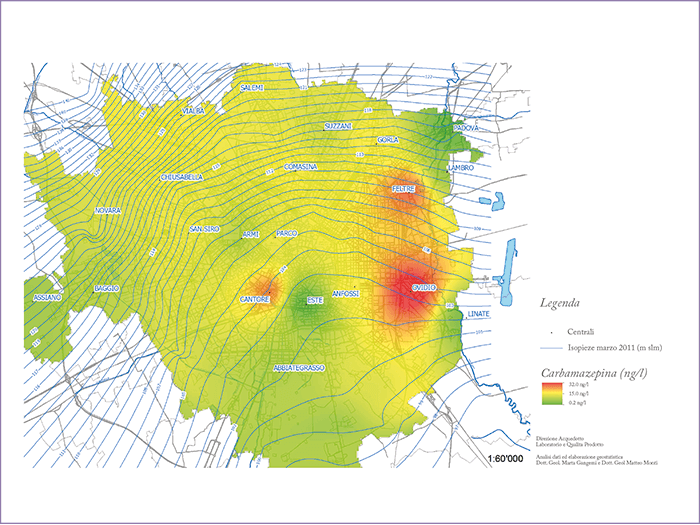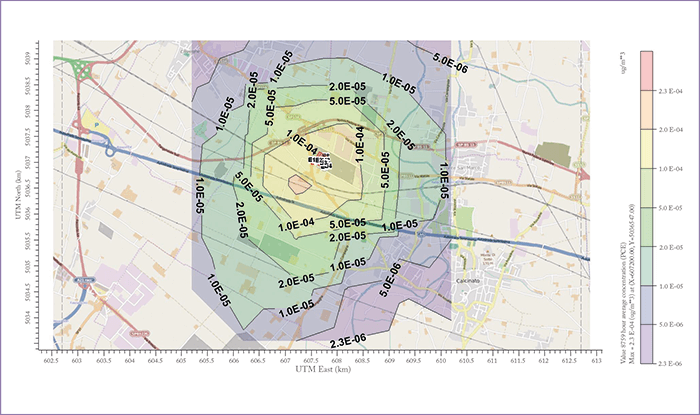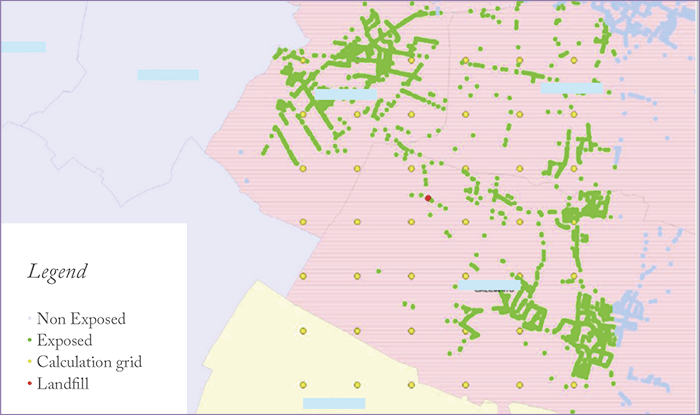July 10, 1976. Chemical company ICMESA was manufacturing trichlorophenol (an active ingredient of herbicides) and an intermediate product for hexaclorophene (an antibiotic). The new synthetic pathway, developed by Givaudan chemists (1), was profitable but dangerous – it can result in an exothermic side reaction. Just after midday on an otherwise peaceful Saturday an accident occurred, releasing a six-tonne chemical "cloud". The cloud carried a miscellanea of toxic compounds, including dioxin (2,3,7,8 TCDD), which caused severe pollution in the densely populated Italian municipality – the so-called “Seveso disaster” (Figure 1). Intensive monitoring plans were made to map the risk to the population – and assess the need for quarantines and decontamination. Back in 1976, mass spectrometers were available in Italy, but only in a limited number of laboratories, mainly in the petrochemical industry (2). The Mario Negri Institute cooperated in the analysis of dioxin congeners in thousands of samples to map soil and ecosystem contamination (3).
Harnessing the space dimension
We are all familiar with meteorological maps – the space dimension of weather – but we don’t typically think about (or even know of) the computational efforts at work behind them. Solving meteorological equations to predict the weather was made possible by polymath John von Neumann, who had access to the US Army’s Electronic Numerical Integrator and Calculator – ENIAC. Von Neumann considered atmospheric processes to be one of the most complex modeling problems but nevertheless programmed ENIAC to perform the world’s first “computerized” weather forecasts in the 1950s. Today, such modeling allows us to interact iteratively with reality; by continuously assessing the measurements used to build models against the accuracy of predictions, our models evolve and thrive. The results of mapping models – like meteorological maps – are widely used today and are essential in understanding reality. When trying to understand the effects of the Seveso disaster, which affected up to 20 km2 of the surrounding area, the importance of mapping and the need to conserve the space dimension of the environmental samples collected was self-evident. Soil and biological samples were brought into the laboratory, extracted, purified and analyzed by mass spectrometry (the gold standard for environment toxicologists) and the resulting data were used to draw contamination maps – the reality – to inform remediation plans. It was during those testing times that our laboratory developed the trace and ultra-trace environmental analytical culture that I learned when entering the Institute – and that remains strong within me today. Air samples now play a significant role in monitoring “everyday” pollution, but present specific challenges when it comes to sampling and storage, especially for volatile analytes. Adsorbents and impingers suffer from a potential breakthrough of the analyte because of saturation; bags and canisters might adsorb or degrade analytes – or lose the sample via permeation through the polymeric walls. On-site analytical approaches are therefore becoming increasingly commonplace, especially with the advent of portable instrumentation. But there is a price. Reduced complexity (compared with laboratory-grade instrumentation) results in less sensitivity and higher data uncertainty – unacceptable when considering our trace and ultra-trace heritage. Back in 1992, we overcame these problems by developing a transportable GC-MS with an on-line permeation tube, using deuterated analogs in the air sample as internal standards (4). The instrument was designed to accurately monitor benzene, toluene ethylbenzene and xylene (BTEX) air pollution (5). Fast gas chromatography allowed a relatively high sampling frequency, with a full analytical cycle time of 5 minutes. The instrument, derived from small quadrupole residual gas analyzer hardware, was installed in an early zero-emission, electric-vehicle prototype from Fiat (Figure 2) to avoid influencing the results with our own BTEX emissions (6). The instrument was capable of sampling and analyzing data while running in traffic – down at ppb levels – and allowed two dimensional (2D) mapping of carcinogens in urban traffic, demonstrating a highly variable concentration range of analytes, but also proving that the concentration of pollutants in the middle of the road where drivers are exposed, are 3–5 times higher than concentrations at the curbside, where air quality monitors are generally installed. The same approach, developed on a more robust Agilent GC/MSD system, allowed us to measure airborne vinyl chloride monomer and dichloroethane inside production plants, both mapping diffuse pollution of these gases and pinpointing leaks in a large chemical plant. VCM data, along with meteorological data from an on-board monitoring station, were also used to feed an on-line Gaussian air diffusion model to describe air concentration levels outside the plant – at nearby hospitals, homes and schools (7, see Figure 3).Surviving the “urban millennium”
The space dimension in macro environments is used extensively in our laboratory in odor pollution studies. Our approach (now a suggested method in our Regional Guidelines: DGR Lombardia 16/4/2003, N. 7/12764) is based on a simple GC-MS analysis with isotopically-labeled internal standards and solid-phase microextraction pre-concentration – and allows us to identify odorants at low ppb/high ppt levels. Overlapping air diffusion model maps with ambient air grab samples makes it possible to identify sources of odor pollution (see Figure 4). Multivariate chemometrics are needed for odor source identification in complex situations where different odor sources (or different processes) are present in a confined space. Water samples can also offer rich information when the space dimension is maintained. Trace analysis of contaminants can be used not only as an early warning system (8), but also as a tool to describe contemporary urban regions for regional planning. During the opening of the twenty-fifth session of the General UN Assembly (2001), Nobel laureate Kofi Annan described a world entering an “urban millennium” and called for the international community to rise to its many challenges (9). The UN’s population division calculated that urban regions would house more than half of the world’s population by 2016, and that issues such as outward urbanization would have significant implications not only for living conditions but also for the environment: “The aquifer will overwhelm sewage wastewater systems, threatening water supplies” (10). It is now 2017 and though we are not yet in that situation, Cariplo Bank Foundation recently supported a large study of Milan’s aquifer to accurately describe water supply status. To that end, we studied the presence and fate of emerging contaminants in the complex aquifer system of Milan’s urban region, where the water-bearing deposits are more than 250 m deep and can be divided into four large-scale geological units separated by clay deposits, called aquitards. Samples were acquired – twice, in different campaigns – from seven points in the three rivers of Milan, from all 31 wells from the first water table, and twice from 21 wells of the second and third water table. Results showed that emerging pollutants from the rivers enter the first water table – but also, probably because of intense, increasing underground construction activities in recent years, surface water pollutants reached the second and third water tables, which should, in theory, be confined by the large clay deposits. Compounds that directly derive from human activity, such as pharmaceuticals, are detected not only in surface waters, but in all aquitards. The spatial dimension of analytical data allows us to describe macro areas where water table confinement is less efficient (Figures 5 and 6), to help in regional planning. In Milan, the population density is becoming increasingly critical – an environmental policy that ensures proper water management is key for the benefit of all citizens.


Exposure and response
Studies directly bound to human health can also benefit from spatial information. Typically, when environmental health impact assessments are made, health effect data are collected on an aggregate level (based on regional or urban administrative units) and health effects are estimated based on concentration–response functions – accurate exposure modeling needs to be performed. Overall health damage is derived from exposure–response functions, which are not aggregated into administrative units but on individual exposure. To further confound matters, health status data are not typically available at the individual level (in part due to concerns over confidentiality). The upshot? The use of aggregated data could mask local hotspots and smooth out spatial variations in impact, meaning that health effects caused by personal exposure to pollutants is over- or underestimated. What if highly defined spatial data and disaggregated source data were used? We would be able to provide more accurate estimates of exposure and also highlight the effects of specific sources. In a recent study, we collaborated with environmental epidemiologists in a retrospective cohort study to investigate health effects caused by landfill emissions. It was possible to estimate ambient air pollution at a relatively high resolution by modeling atmospheric dispersion of selected pollutants and validating the data in monitoring campaigns, but exposure assessment was much more complex. In this case, obtaining health data was possible because of our collaboration with the local health service. Individual but anonymous data about hospital admissions for acute pathologies that are associated with exposure to landfill emissions (cardiovascular, reproductive and respiratory diseases) but also chronic diseases (endocrine disorders and child cancer) were collected over a ten-year period. It is fair to say that incorporating the space dimension into the study was costly in terms of the amount of data; even though the municipalities were relatively small, a total of approximately 30,000 residents over ten years results in the need to analyze 1.5 million health records. After geocoding all subjects, residential history during the ten-year period was overlapped onto the map from the pollutant diffusion model (see Figure 7), and an exposure value was attributed to each individual subject (Figure 8). We could then accurately calculate relative risks using concentration–response functions with a proportional regression model showing a weak association hypothesis of local health effects due to the landfill. Spatial outcome data, used to assess risk within this context, did not show an association with distance and, more, was in counter-tendency with the expected effects of the period activities of the landfill.From macro to micro
In pharmacology, many efforts have been made over the past decade to develop new analytical techniques aimed at localizing/mapping the relative distribution of drugs within micro environments, such as biological samples. Classical pharmacokinetic studies measure the average drug accumulation in tissues, assuming homogeneous distribution of the molecule through the different organs. It fails to give exact knowledge of how a compound localizes and distributes inside a tissue, which is critical if we are to ascertain whether it reaches the intended target site – and how. Mass spectrometry imaging (MSI) is ideal for this purpose, offering us the power to directly measure, point-by-point, the chemical composition of a sample – and so maintaining spatial information. From 1997 onward – thanks largely to the works of Caprioli (11) – MSI gained popularity as a technique to investigate the distribution of large biomolecules in tissue sections. Specific ionization techniques allow direct measurements of low molecular weight compounds, like drugs and metabolites (12). We specifically designed nanostructured matrices that allow the imaging of different drugs with high specificity, sensitivity and reproducibility, based on metallic gold and titanium nanoparticles, in combination with inorganic halloysites and organic carbon nanotubes (13). Two-dimensional (2D) data is particularly important in oncology, where the overall tissue data reveals very little about a drug’s ability to penetrate a tumor. The local microenvironment greatly affects drug penetration, so that a tissue homogenate cannot tell us whether a chemotherapeutic drug reached an effective concentration in all tumor cells or not. Gathering 2D quantitative drug data inside tumors helps us to understand mechanisms of drug resistance, and to develop new strategies to improve penetration of chemotherapy into the tumor. To better describe the tumor microenvironment, three-dimensional (3D) studies made up of serial tissue slices were a logical next step (see Figure 9).

Quantitative imaging of drug penetration inside a tumor revealed a very heterogeneous drug distribution. In a model of malignant pleural mesothelioma (MPM, see Figure 10) – a very heterogeneous neoplasm – drug was detected in only 62 percent of the tumor volume, with concentrations ranging from 0.2 to >100 µg/g, while in the remaining 38 percent of the tumor, drug concentrations were lower than our limit of detection (0.2 µg/g). The result led us to “speculate that the in vivo resistance may be largely related to the inflammatory tumor microenvironment, possibly associated with the low and heterogeneous drug distribution” (14). The importance of the space dimension has been underscored recently by studies that focus on tissue identification by mass spectrometry during cancer surgery. Direct MSI techniques are demonstrating great potential for identifying the margins of a tumor during surgery (15). The identification of cancer cells left behind after surgery is currently confirmed by time-consuming histopathological examination of tissue samples during the operation. MSI-based approaches are faster and more accurate, which could decrease local recurrence and increase overall survival.
Chemicals everywhere?
Of course! Trace and ultra-trace analysis, historically developed in the analytical labs for the dioxins issue, are now widely used to describe our environment in terms of emerging contaminants, such as pharmaceuticals, drugs of abuse, and even for personal care products. Grab samples, single point or limited samples inform us about the potential presence of chemicals in the environment but do not answer our health-based questions. Here, a deep exposure assessment process is highly desirable for an accurate health impact assessment. Building contamination or concentration maps, using diffusion models, is a gold standard method that offers important quantitative information about chemical presence. Building contamination maps with analytical measurements, compared to model estimation, undoubtedly has a different value and impact. Understanding the distribution of data rewards scientists with new tools to probe environmental contamination issues or describe the presence of pharmaceuticals or drugs in our environment – and it pushes us towards prevention rather than cure. The analysis of a tissue homogenate indicates drug presence, but has no useful information on treatment efficacy; it does not tell us if the drug reaches the target and, if it does, whether the concentration or dose is effective. With new instrumentation, it is possible to maintain spatial quantitative information even at the micro dimension of tissues, allowing us to go beyond simple descriptions. Here, understanding the distribution of data supports hypotheses, verifies pathologies, and measures treatment efficacy. Whether in macro or micro environments, retaining analytical information in the space dimension offers flexibility and power. But it is not without challenges. Mass spectrometry has a well-deserved reputation for sensitivity and specificity, and managing mass spectrometry data has always required state-of-the art computing hardware. Adding the space dimension to the data flow takes the computing challenge out of the realm of today’s personal computers; processing the additional data is likely to be a job for powerful remote machines (16). Most of the applications described in this article take advantage of several external software packages – some ready-to-use and some custom – to elaborate and present results. As an analytical scientist, I hope that all vendors will eventually settle on a common, open-source data format for mass spectrometry that will set us free to use data in innovative ways and shed new light on our laboratory results – including the ability to take advantage of the space dimension.Enrico Davoli is Head of the Mass Spectrometry Laboratory in the Environmental Health Sciences Department at IRCCS Istituto di Ricerche Farmacologiche “Mario Negri,” Milan, Italy, and President of the Italian Mass Spectrometry Society. Acknowledgements These reflections come from many years of research in the environmental health field. So many beautiful students helped us with their innovative ideas and enthusiasm and are gratefully acknowledged. Financial support from sponsors, such as the CARIPLO bank foundation, has been the driving force for many studies, such as the large underground water studies in the water tables of Milan (conducted with Metropolitana Milanese Spa, Integrated Water Services for the City of Milan). Tumor heterogeneity studies are collaborations with our Oncology Department. Finally I need to thank the Environmental Epidemiology and the Cancer Registry Unit at Fondazione IRCCS Istituto Nazionale dei Tumori, and MB, in our Public Health Department, for infinite discussions that helped me in developing the idea of the space dimension and this manuscript.
References
- T Margerison et al., New Scientist, 89, 334–336 (1981). F Turco, “Archi e tracce. La spettroscopia di massa tra fisica e chimica”, La Goliardica Pavese: 2004. P Adamoli et al., Ecol Bull, 27, 31–38 (1978). E Davoli et al., J High Res Chromat, 16, 626–628 (1993). E Davoli et al., J Am Soc Mass Spectrom, 5, 1001–1007 (1994). E Davoli et al., Int Arch Occup Environ Health, 68, 262–267 (1996). E Davoli et al., Proceedings of the 45th ASMS Conference, June 1–5 1997, p 219. E Davoli et al., Chemosphere, 16, 1425–1430 (1987). United Nations (2001). Available at: http://bit.ly/2pqiNGe. Accessed May 8, 2017. United Nations (2016). Available at: http://bit.ly/2qgI0am. Accessed May 8, 2017. RM Caprioli et al., Anal Chem, 69, 4751–4760 (1997). L Morosi et al., PLoS One, 8, e 72532 (2013). S Giordano et al., Nanomaterials, 7, 71 (2017). Giordano et al., Sci Rep, 6, 37027 (2016). ER St John et al., Trends Anal Chem, 85, 2–9 (2016). Metaspace. Available at: http://metaspace2020.eu. Accessed May 8, 2017.




